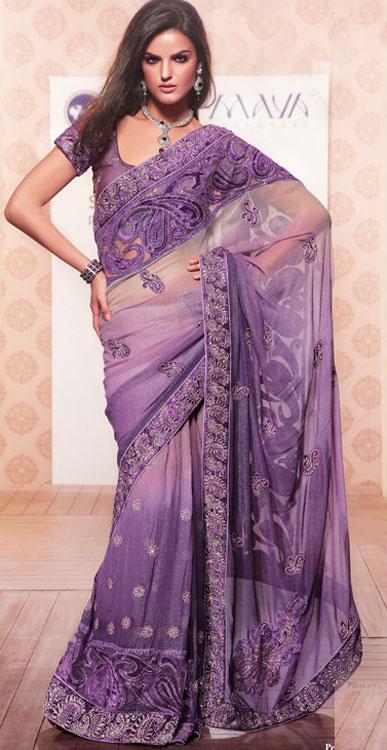Fashion Of Indian Women Biography
source(google.com.pk)
South Indian culture though with its visible differences forms an important part of the Indian culture. The South Indian Culture is essentially the celebration of the eternal universe through the celebration of the beauty of the body and motherhood.It is exemplified through its dance, clothing, and sculptures.South Indian women traditionally wear the sari while the men wear a type of sarong, which could be either a white dhoti or a colourful lungi with typical batik patterns. The sari, being an unstitched drape, enhances the shape of the wearer while only partially covering the midriff. In Indian philosophy, the navel of the Supreme Being is considered as the source of life and creativity. Hence by tradition, the stomach and the navel is to be left unconcealed, though the philosophy behind the costume has largely been forgotten.This makes the realization of sharira-mandala, where in Angikam bhuvanam yasya (the body is your world) unites with the shaarira-mandala (the whole universe), as expressed in the Natyashastra. These principles of the sari, also hold for other forms of drapes, like the lungi or mundu or anchey (a white lungi with colourful silk borders in kannada) worn by men. The lungi is draped over clockwise or counterclockwise and is tied at the back or fixed just along the waist line. It's sometimes lifted till knee and tied at the waist leisurely or just held in hand to speed up walking. In Andhra and in parts of north karnataka men wear kachche panchey where it is tied at back by taking it between legs.Similar pattern is seen in women. All over the peninsular coastal region men wear coloured lungis and women wear sari in a way tying it at back.The Araimudi (araimuti) was worn by young Tamil girls.
The Araimudi (araimuti) (Tamil: அரைமுடி, araimūḍi ?) is a small silver metal plate shaped like a heart or a fig leaf formerly worn by young Tamil girls on their genitals. "Arai" means loin and "mudi" means cover. The araimudi is also known as the "Genital shield" and an araimudi was mentioned in the "Guide to the principal exhibits in the Government Museum, Pudukkottai", by M. S. Chandrasekhar, published in 1966 as being displayed in an exhibit in the Madras Government Museum. "A Manual of the Salem district in the presidency of Madras, Volume 1" said "The children sometimes, to the age of ten years or more, go in a state of nudity, relieved perhaps by a piece of string round the waist which sustains the "araimudi" or heart-shaped piece of silver, which calls attention to what it purports to conceal." The "Madras district gazetteers, Volume 1, Part 1" said 'Little girls, up to the age of about 3, wear nothing but the little heart-shaped piece of silver suspended by a waist-cord (arai- mudi) " which calls attention to what it purports to conceal."'"Percival's Tamil-English dictionary", edited by P. Percival defined Araimudi as "அரைமுடி arai múḍi, A small plate of gold or silver, appended to the girdle of female children, for the sake of decency.
The salwar is gathered at the waist and is held by a drawstring. With the change in fashion trends, the pants are designed to be wide, baggy or narrow. Other variations include patiala salwar (with more pleats), churidhar (salwar with pleats surrounding the ankle) or parallels (wide pants). Other designer salwar kameez trends include pakistani salwar kameez and Anarkali salwar kameez.
A salwar kameez could have thread work, badla work, bandhej work (tie-and-dye) or phulkari patterns. These suits could be either ready made or tailor-made. These days semistitched suits are also available that have patterns like ready made salwar kameezes yet can give the fit of a made-to-order dress.
Salwar suits are available in different fabrics and viscose is one of the fabrics available in suits. Viscose is mixed fabric which is commonly used now days in salwar suits.
Crepe is very common fabric in formal wears. Crepe salwar suits are available in both prints and embroideries. Available in different colors, crepe salwar suit looks perfect.
Kundan embroidery is one of the most exclusive and traditional embroidery used on salwar suits. Kundan salwar suits are available in vogue colors and fabrics.
Winter salwar suits are available in different fabrics like georgette, silk, lizi bizi, crepe in different bright tones of red, magenta, green, blue, black and lots mor
Summer salwar suits are available in different cool fabrics like net, chiffon, organza, cotton, georgette in both prints and embroideries in pastel tones like peach, pink etc.
Booti work looks amazingly beautiful on salwar kameez. Salwar kameez in different fabrics like crepe, georgette, chiffon are available in different colors like red, green etc
Fashion Of Indian Women

Fashion Of Indian Women
Fashion Of Indian Women
Fashion Of Indian Women

Fashion Of Indian Women
Fashion Of Indian Women
Fashion Of Indian Women

Fashion Of Indian Women
Fashion Of Indian Women
Fashion Of Indian Women
Fashion Of Indian Women
No comments:
Post a Comment